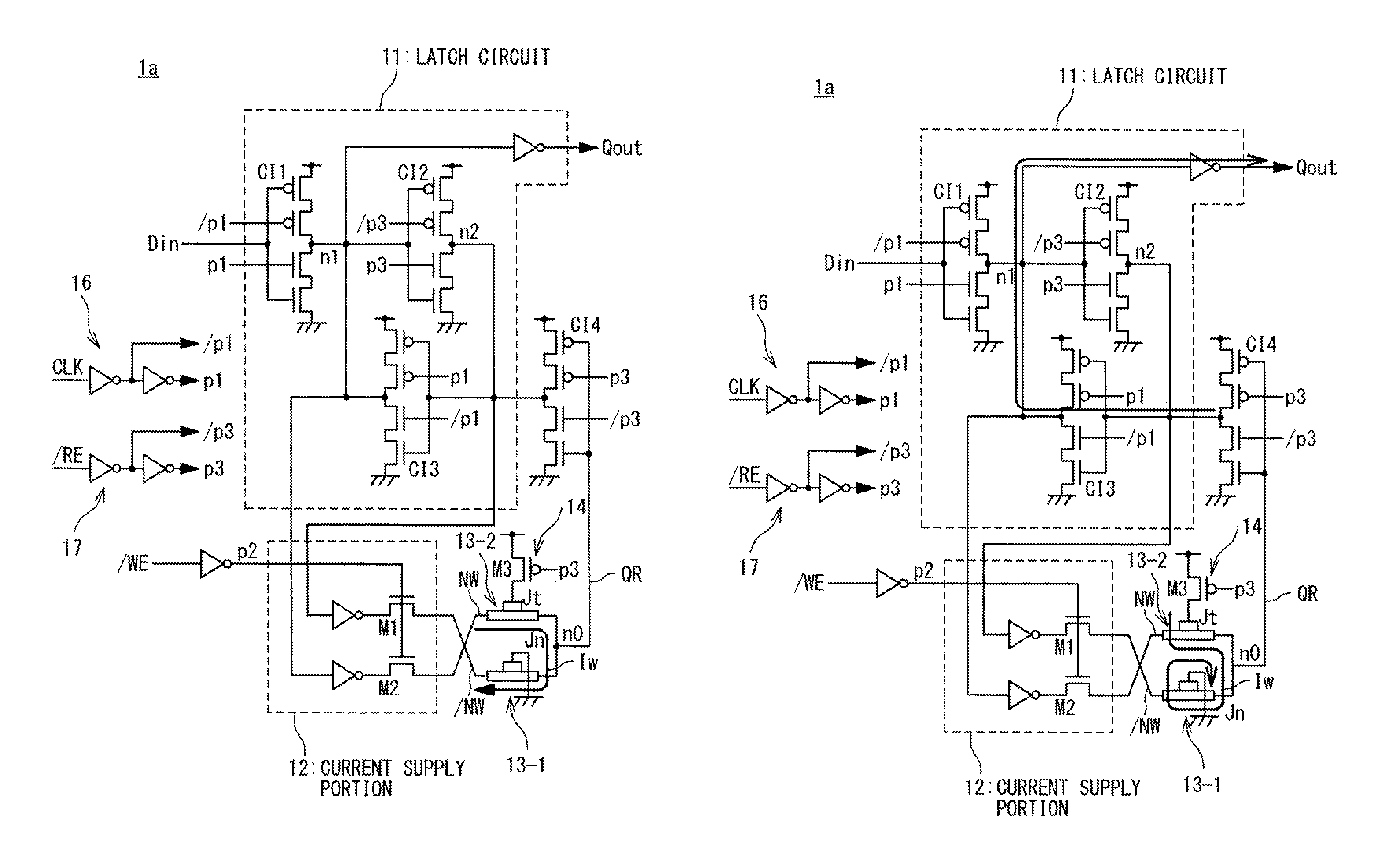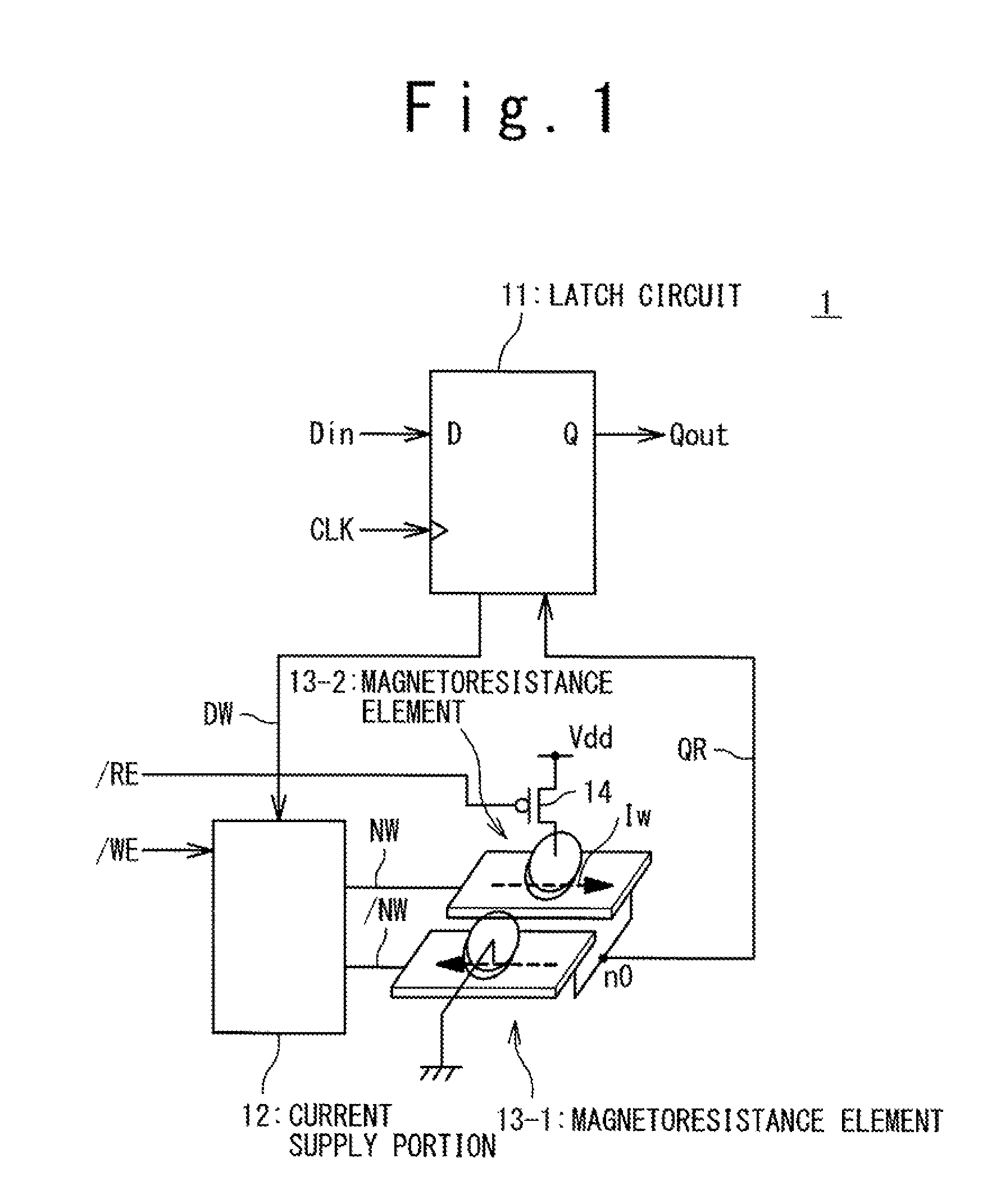Nonvolatile latch circuit and logic circuit using the same
a latch circuit and logic circuit technology, applied in the direction of digital storage, instruments, semiconductor devices, etc., can solve the problems of increasing operating power due to speed increase, affecting the efficiency affecting the operation of the latch circuit, etc., and achieve high reliability and efficient holding
- Summary
- Abstract
- Description
- Claims
- Application Information
AI Technical Summary
Benefits of technology
Problems solved by technology
Method used
Image
Examples
first embodiment
[0046]A configuration of a nonvolatile latch circuit according to a first embodiment of the present invention will be described. FIG. 1 is a schematic configuration diagram illustrating the configuration of the nonvolatile latch circuit according to the first embodiment of the present invention. The nonvolatile latch circuit 1 is a nonvolatile latch circuit using a magnetoresistance element exemplified by an MTJ element. The nonvolatile latch circuit 1 includes a latch circuit 11, two magnetoresistance elements 13-1 and 13-2, and a current supply portion 12.
[0047]During a time period that a clock signal CLK is at a high level (or a low level), the latch circuit 11 temporarily holds (latches) input data Din supplied from another circuit (not illustrated) within a logic circuit. Then, the latch circuit 11 outputs the latched data (latch data) as output data Qout. Also, the latch circuit 11 supplies a data signal DW (or an inverted signal / DW of the data signal DW) indicating the latch...
second embodiment
[0095]An example in which a nonvolatile latch circuit using a magnetoresistance element is applied to a delay flip-flop (DFF) will be described as the nonvolatile latch circuit of the present invention. FIG. 10 is a schematic configuration diagram illustrating a configuration of a nonvolatile latch circuit according to a second embodiment of the present invention. The nonvolatile latch circuit 1b uses, in the delay flip-flop of a master-slave system, as a slave latch, a circuit equivalent to the high through latch circuit (nonvolatile latch circuit 1a) illustrated in FIGS. 5A and 5B. The nonvolatile latch circuit 1b includes a master latch circuit 11-1, a slave latch circuit 11-2, a current supply portion 12, signal conversion portions 16 and 17, a clocked inverter CI15, and magnetoresistance elements 13-1 and 13-2.
[0096]The master latch circuit 11-1 includes clocked inverters CI11 and CI12. The clocked inverter CI11 is supplied with input data Din and clock signals p1 and / p1, and ...
third embodiment
[0111]Another example in which a nonvolatile latch circuit using a magnetoresistance element is applied to a delay flip-flop (DFF) will be described as the nonvolatile latch circuit of the present invention. FIG. 13 is a schematic configuration diagram illustrating a configuration of a nonvolatile latch circuit according to a third embodiment of the present invention. The nonvolatile latch circuit 1c uses, in the delay flip-flop of a master-slave system, the non-volatile low through latch circuit using the magnetoresistance elements based on the first embodiment as a master latch circuit, and the non-volatile high through latch circuit using the magnetoresistance elements based on the first embodiment as a slave latch circuit. The nonvolatile latch circuit 1c is provided with a master latch circuit 11-1a, a clocked inverter CI24, a current supply portion 12-1, magnetoresistance elements 13-11 and 13-21, a slave latch circuit 11-2a, a clocked inverter CI27, a current supply portion 1...
PUM
 Login to View More
Login to View More Abstract
Description
Claims
Application Information
 Login to View More
Login to View More - R&D
- Intellectual Property
- Life Sciences
- Materials
- Tech Scout
- Unparalleled Data Quality
- Higher Quality Content
- 60% Fewer Hallucinations
Browse by: Latest US Patents, China's latest patents, Technical Efficacy Thesaurus, Application Domain, Technology Topic, Popular Technical Reports.
© 2025 PatSnap. All rights reserved.Legal|Privacy policy|Modern Slavery Act Transparency Statement|Sitemap|About US| Contact US: help@patsnap.com



